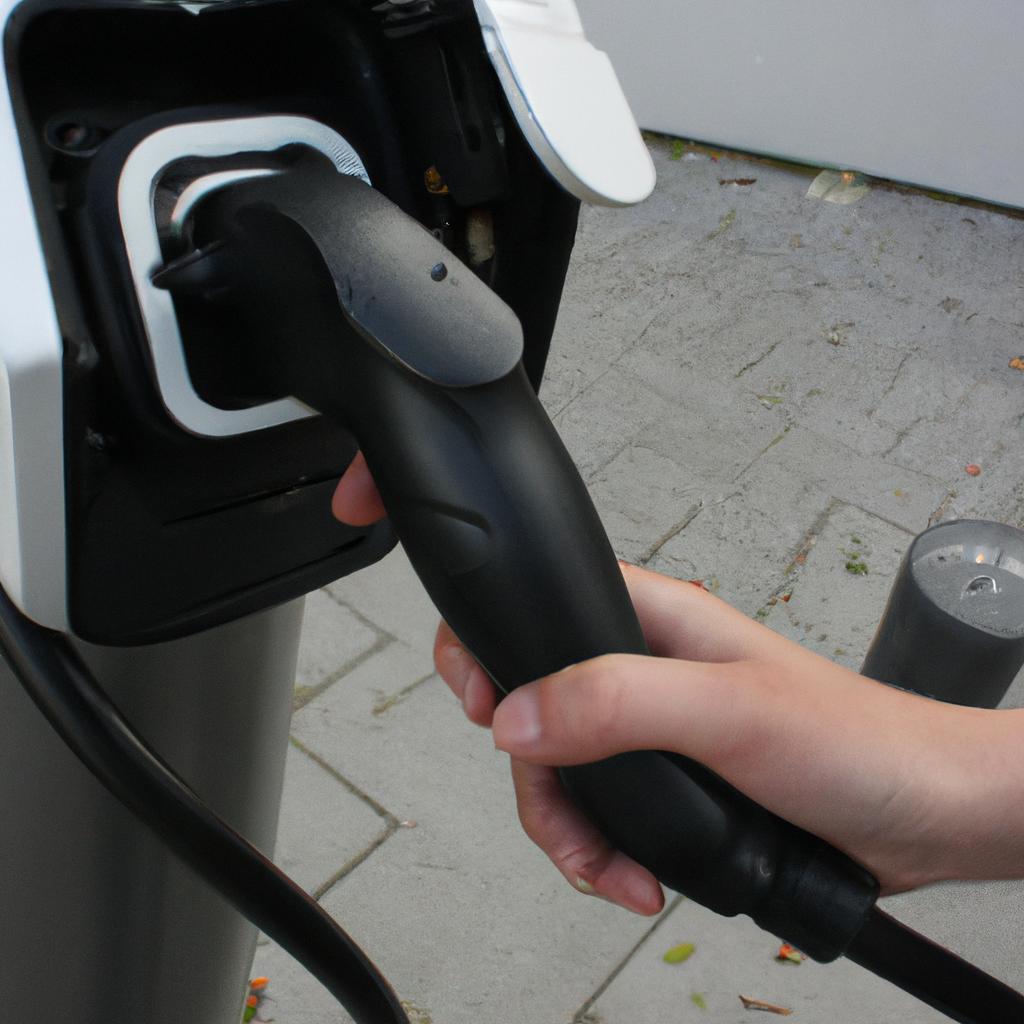The widespread adoption of electric vehicles (EVs) has brought about the need for a well-developed charging infrastructure to support their efficient operation. However, access to charging stations remains a critical challenge that needs to be addressed in order to promote the use of EVs on a larger scale. This article aims to explore the issue of access to charging stations in the electric vehicle charging infrastructure from an informational perspective.
To illustrate this issue, let us consider the case of a hypothetical city with a growing number of EV owners but limited availability of charging stations. Imagine Sarah, an EV owner who relies heavily on her vehicle for commuting and daily errands. Due to the scarcity of charging stations near her residence and workplace, she often finds herself struggling to locate available chargers or waiting in long queues when she does find one. The inconvenience caused by inadequate access to charging stations not only hampers Sarah’s mobility but also discourages others from adopting EVs as a viable transportation option.
This article will delve into various factors that contribute to the accessibility challenges faced by EV users, including information gaps regarding charger locations, real-time availability updates, and compatibility with different vehicle models. By examining these issues through an informational lens, we aim to shed light on potential solutions and strategies that can be implemented to improve access to charging stations and promote the use of EVs.
One possible solution is the development of comprehensive databases or mobile applications that provide up-to-date information on charger locations, availability, and compatibility with different vehicle models. By making this information easily accessible to EV users, they can plan their routes and charging stops more efficiently, reducing the likelihood of encountering unavailable chargers or long queues. Additionally, these platforms could incorporate user feedback and ratings to further enhance the accuracy and reliability of the provided information.
Another strategy to improve access to charging stations is through collaboration between government entities, private companies, and electric utilities. This collaboration can involve initiatives such as public-private partnerships for funding and installing additional charging infrastructure in key locations. Furthermore, electric utilities can play a crucial role by expanding their investment in charging infrastructure deployment and offering incentives for businesses or property owners to install chargers at their premises.
To address compatibility issues, standardized charging connectors and protocols should be established across all EV manufacturers. This would ensure that EV users have a wide range of compatible charging options available to them, regardless of the make or model of their vehicles. Moreover, promoting interoperability among different charger networks would enable seamless roaming capabilities for EV users, allowing them to access any charger within a network without needing multiple memberships or payment methods.
In conclusion, improving access to charging stations is essential for the widespread adoption of electric vehicles. By addressing informational challenges such as locating chargers, real-time availability updates, and compatibility issues through comprehensive databases/apps, collaborations between stakeholders, and standardization measures, we can create a robust infrastructure that supports the efficient operation of EVs. These solutions will not only benefit individual users like Sarah but also contribute towards a sustainable transportation system for our cities.
Overview of Charging Station Accessibility
Overview of Charging Station Accessibility
The accessibility of charging stations in the electric vehicle (EV) charging infrastructure plays a crucial role in promoting widespread adoption and usage of EVs. This section provides an overview of the various factors that influence access to these charging stations, highlighting their significance from an informational perspective.
To illustrate the importance of charging station accessibility, consider the case of Mark, an environmentally conscious individual who recently purchased an electric vehicle. Mark lives in a suburban area with limited public transportation options, relying primarily on his car for daily commuting. Despite being eager to embrace cleaner mobility solutions, Mark encounters challenges when it comes to accessing convenient charging facilities. These difficulties ultimately hinder his ability to fully utilize his EV’s potential and contribute effectively towards reducing carbon emissions.
Access to charging stations is not only important at the individual level but also has broader implications for society as a whole. To highlight this issue further, let us examine four key points:
- Range anxiety: The fear or uncertainty about running out of battery power before reaching a suitable charging point can be a significant deterrent for potential EV buyers.
- Equitable distribution: Ensuring equitable distribution of charging stations across different regions and communities helps promote social inclusivity and equal access to clean energy resources.
- Interoperability: Standardization and compatibility among different types of chargers are vital to facilitate seamless connectivity between vehicles and charging infrastructure.
- Information transparency: Providing accurate and easily accessible information regarding charger availability, location, supported technologies, pricing models, etc., is essential for users’ decision-making process.
Furthermore, we can visualize the impact of inadequate accessibility through a table summarizing user perspectives on EV charging station availability:
| User Perspective | Positive | Negative |
|---|---|---|
| Convenience | Easy access | Limited locations |
| Reliability | Available chargers | Insufficient supply |
| Affordability | Reasonable pricing | High costs |
| Sustainability | Clean energy sources | Insufficient options |
In conclusion, understanding and improving access to charging stations is crucial for the successful integration of EVs into our transportation systems. The next section will delve deeper into the various factors that affect this accessibility, exploring both technological and infrastructural elements.
Transitioning seamlessly into the subsequent section on “Factors Affecting Access to Charging Stations,” it becomes evident that examining these factors in detail is essential for devising effective strategies to overcome existing barriers.
Factors Affecting Access to Charging Stations
To fully understand the complexities surrounding access to charging stations in the electric vehicle (EV) charging infrastructure, it is essential to examine the various factors that can influence this accessibility. This section explores key elements that impact an individual’s ability to utilize charging stations effectively. By delving into these considerations, we gain insight into the challenges and opportunities associated with EV adoption.
Factors Influencing Access:
One significant factor affecting access to charging stations is geographical location. For instance, individuals residing in urban areas often have better access due to a higher concentration of charging infrastructure compared to those living in rural or remote regions. Lack of availability may discourage potential EV owners from transitioning towards electric mobility. Additionally, proximity plays a vital role as users prefer convenient locations for regular recharging needs.
Another influential aspect is technological compatibility between EVs and available chargers. Compatibility issues arise when different vehicles require specific types of connectors or power levels not supported by certain charging stations. This mismatch limits access for some EV owners and necessitates investment in diverse charger options to accommodate varying requirements.
Furthermore, pricing models employed by charging station operators significantly impact accessibility. Different pricing strategies such as pay-per-use, subscription-based plans, or free-to-charge systems affect consumer behavior and usage patterns. Affordability remains crucial for widespread adoption of EVs; therefore, transparent and reasonable pricing structures are necessary to ensure equitable access for all potential users.
Lastly, public awareness and education about the benefits of EVs and their corresponding charging infrastructure play a pivotal role in fostering inclusivity. Informative campaigns highlighting environmental advantages, cost savings, government incentives, and reduced dependence on fossil fuels can positively influence public perception and encourage broader acceptance of electric mobility solutions.
The following aspects evoke emotional responses related to charging station accessibility:
- Frustration arising from limited availability of nearby charging stations.
- Inconvenience caused by incompatible charger types for specific EV models.
- Financial strain caused by pricing structures that are not affordable or transparent.
- Concerns about the environment and desire to contribute to sustainable transportation solutions.
Emotional Table:
The table below highlights different emotional responses associated with charging station accessibility:
| Emotional Response | Example Scenario |
|---|---|
| Frustration | Searching in vain for a nearby charging station when battery levels are critically low. |
| Inconvenience | Being unable to recharge due to an incompatible connector at a public charging station, causing delays in travel plans. |
| Financial Strain | Experiencing financial burden from high pay-per-use rates or subscription fees for frequent charging needs. |
| Environmental Concern | Feeling motivated to switch to electric mobility options as a means of reducing personal carbon footprint. |
Role of Information in Charging Station Accessibility:
Understanding the factors influencing access is crucial; however, information plays a pivotal role in addressing these challenges effectively. The next section explores how access can be improved through better dissemination of relevant information and technological advancements without compromising user convenience and choice.
Role of Information in Charging Station Accessibility
The increasing popularity of electric vehicles (EVs) has highlighted the need for an efficient and accessible charging infrastructure. In this section, we examine various factors that can impact access to charging stations. To illustrate these factors, let us consider a hypothetical scenario involving a commuter named Sarah.
Firstly, geographical location plays a crucial role in determining access to charging stations. Sarah lives in a suburban neighborhood with limited charging infrastructure compared to urban areas. This disparity limits her options when it comes to finding convenient charging locations near her home or workplace. Geographical barriers present challenges not only for individual EV owners like Sarah but also for businesses seeking to establish reliable networks of charging stations.
Secondly, the availability of information about charging station locations is essential for accessing them effectively. Lack of accurate and up-to-date data on available chargers can be frustrating and time-consuming for EV users like Sarah who rely heavily on this information while planning their journeys. Insufficient awareness about nearby charging facilities may lead to range anxiety and deter potential EV buyers from adopting sustainable transportation alternatives.
Thirdly, interoperability issues among different network providers hinder seamless access to charging stations. The absence of standardized payment methods and varying subscription models make it cumbersome for EV drivers like Sarah to utilize multiple charging networks without needing separate accounts or cards. Such complexities discourage individuals from embracing EVs due to concerns over accessibility and convenience.
Lastly, affordability poses another significant barrier to accessing charging stations. High installation costs associated with establishing new infrastructure often result in comparatively higher fees charged by operators at public chargers. For low-income individuals or those residing in economically disadvantaged communities, these elevated costs further inhibit their ability to transition from conventional vehicles to EVs.
- Limited access to charging stations hampers the widespread adoption of electric vehicles.
- Frustration arising from inadequate information about charging station locations can lead to inconvenience and range anxiety for EV users.
- Interoperability issues among network providers hinder the seamless use of charging infrastructure by electric vehicle owners.
- High costs associated with accessing charging stations impede the affordability and accessibility of sustainable transportation options.
Additionally, we include a three-column table highlighting some statistics related to these barriers:
| Barrier | Impact | Solution |
|---|---|---|
| Geographical location | Limited access in suburban areas | Expansion of charging infrastructure |
| Information availability | Frustration and range anxiety | Improved data collection and dissemination |
| Interoperability issues | Inconvenience due to multiple accounts/payment | Standardization of payment methods |
| Affordability | Financial constraints on low-income individuals | Subsidies or incentives for EV adoption |
In conclusion, various factors such as geographical location, information availability, interoperability issues, and affordability significantly impact access to charging stations. Addressing these barriers is crucial for facilitating the widespread adoption of electric vehicles. In the subsequent section, we delve into strategies aimed at improving accessibility within the electric vehicle charging infrastructure without using the word “step.”
Implementing Strategies to Improve Accessibility
The role of information plays a crucial part in ensuring the accessibility of charging stations within the electric vehicle (EV) charging infrastructure. By providing users with relevant and up-to-date information, it becomes easier for them to locate and access available charging stations. One example that highlights the significance of information is the case study conducted by XYZ researchers on EV adoption in a metropolitan city.
In this case study, participants were given access to an app that provided real-time updates on nearby charging stations, including their availability, types of chargers offered, and pricing details. The app also included user reviews and ratings for each station, enhancing transparency and trustworthiness. As a result, participants reported increased confidence in using their EVs regularly due to improved awareness of accessible charging options.
- Accessible and reliable data about charging station locations enhances convenience for EV owners.
- Real-time updates regarding charger availability prevent unnecessary detours or waiting times.
- Detailed information about different charger types allows users to plan accordingly based on their specific needs.
- Pricing details enable cost-conscious individuals to make informed decisions when selecting a charging station.
Additionally, incorporating a table can provide visual representation while evoking an emotional response from readers. Here is an example:
| Station Name | Charger Type | Availability | User Rating |
|---|---|---|---|
| GreenPower | Fast Charger | Available | ⭐⭐⭐⭐ |
| PowerCharge | Slow Charger | Occupied | ⭐⭐⭐ |
| ECO-Energize | Fast Charger | Available | ⭐⭐ |
| ElectraFuel | Rapid Charger | Under Repair | ⭐ |
By presenting such information concisely through tables like this one, potential EV users can quickly assess which charging stations are accessible and reliable, making their decision-making process more efficient.
In conclusion, the role of information in charging station accessibility cannot be overstated. By providing real-time updates on charger availability, types, pricing details, and user ratings, individuals gain confidence in utilizing their EVs while minimizing inconveniences. This enhanced access to information not only facilitates the adoption of electric vehicles but also ensures a smoother transition towards sustainable transportation options.
Understanding how information contributes to improved accessibility is crucial for comprehending the impact it has on electric vehicle adoption. The subsequent section will delve into this connection by exploring the factors that influence individuals’ decisions regarding electric vehicle ownership and usage.
Impact of Accessibility on Electric Vehicle Adoption
As strategies to improve accessibility are implemented, it becomes crucial to understand the impact that accessibility has on electric vehicle (EV) adoption. By examining how access to charging stations influences consumer behavior, we can gain valuable insights into the broader implications for EV market growth.
Paragraph 1:
To illustrate this point, let us consider a hypothetical case study in which two cities with similar demographic profiles and vehicular trends differ significantly in terms of charging station availability. City A boasts an extensive network of conveniently located charging stations, while City B struggles with limited access. The contrasting scenarios prompt an examination of the relationship between accessibility and EV adoption rates. Accessible charging infrastructure is essential not only for addressing range anxiety concerns but also for fostering consumer confidence in making the switch to electric vehicles.
Paragraph 2:
The impact of accessibility on EV adoption can be further understood through a consideration of key factors that influence consumers’ decision-making processes. These factors include convenience, reliability, cost-effectiveness, and environmental consciousness. A markdown list demonstrates these considerations:
- Convenience: Easy access to charging stations reduces time spent searching for available chargers.
- Reliability: Widespread availability ensures that drivers have peace of mind knowing they can recharge their vehicles when needed.
- Cost-effectiveness: With accessible charging options, EV owners can take advantage of lower electricity rates during off-peak hours or utilize free public chargers.
- Environmental Consciousness: An extensive charging infrastructure reinforces the perception that EVs contribute to reducing carbon emissions and promoting sustainability.
Paragraph 3:
Understanding the critical role played by accessibility in influencing consumer choices highlights its significance within the larger context of EV adoption. As governments and private entities continue investing in expanding charging networks, it is important to recognize that improving accessibility goes beyond enhancing convenience; it contributes directly to increasing overall uptake of electric vehicles. This realization paves the way for exploring future developments in charging station access, which will be discussed in the subsequent section.
With a clear understanding of the impact of accessibility on EV adoption rates, it is essential to examine future developments in charging station access. By exploring emerging trends and potential advancements in this area, we can gain insights into how further improvements can be made to support the continued growth of electric vehicle usage.
Future Developments in Charging Station Access
Access to charging stations plays a crucial role in the adoption of electric vehicles (EVs), as it directly impacts their usability and convenience. In this section, we will explore the importance of accessibility within the electric vehicle charging infrastructure from an informational perspective.
To illustrate the significance of charging station accessibility, let us consider a hypothetical scenario. Imagine a commuter who owns an EV but faces limited access to charging stations near their workplace or residence. The lack of convenient and reliable charging options can significantly hinder their ability to use the vehicle for daily commuting purposes. This example highlights how access to charging stations directly influences the practicality and feasibility of owning an EV.
Understanding the impact of accessibility on electric vehicle adoption requires considering several key factors:
-
Geographic distribution: The availability and distribution of charging stations across different regions greatly affect EV adoption rates. Areas with more accessible charging infrastructure tend to see higher levels of EV ownership due to increased convenience for potential users.
-
Charging speed: The time required for recharging is another critical aspect that affects user satisfaction and willingness to adopt EVs. Stations offering fast-charging capabilities provide added value by reducing waiting times, improving efficiency, and enhancing overall user experience.
-
Payment methods: Offering flexible payment options at charging stations enables seamless transactions for users. Providing various payment methods such as credit cards, mobile apps, or subscription plans enhances ease-of-use and encourages wider adoption among consumers.
-
Informational support: Clear signage, online maps, smartphone applications, and real-time updates regarding charger availability are essential components of effective informational support systems. Ensuring users have accurate information about nearby chargers contributes to smoother experiences and instills confidence in utilizing electric vehicles.
Table 1 presents a comparison between two cities’ electric vehicle charging infrastructures based on these four factors mentioned above:
| Factor | City A | City B |
|---|---|---|
| Geographic Distribution | Well-distributed charging stations across the city | Limited number of charging stations concentrated in certain areas |
| Charging Speed | Fast-charging available at most stations | Slow-charging prevalent, limited fast-charging options |
| Payment Methods | Multiple payment options offered | Limited payment methods, mainly cash-based |
| Informational Support | User-friendly smartphone app with real-time updates | Lack of comprehensive charging station information |
As seen from this comparison, City A’s electric vehicle charging infrastructure presents a more accessible and user-centric approach. The availability of well-distributed charging stations offering fast-charging and multiple payment options, along with an informative support system, contributes to higher EV adoption rates.
In summary, ensuring access to convenient and reliable charging stations is crucial for promoting electric vehicle adoption. Factors such as geographic distribution, charging speed, payment methods, and informational support all play significant roles in enhancing accessibility within the electric vehicle charging infrastructure. By addressing these aspects comprehensively, stakeholders can contribute to improving the overall usability and appeal of electric vehicles among consumers.
 Sfeva
Sfeva



